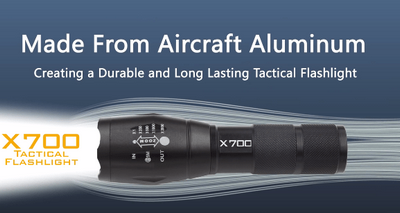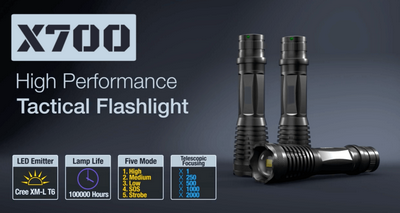Are you in the market for a tactical flashlight? Maybe you’re in law enforcement and need the best equipment to keep yourself and those around you safe. Maybe you’re a hunter or expert shooter and want the best light to aid at night. Or perhaps you do a lot of camping and need a useful tool while out in the woods. Whatever the reason, if you’re shopping for a tactical flashlight, you should know a few things first.
What Is a Tactical Flashlight?
Do you know that flashlight everyone has beneath their kitchen sink? The clunky, plastic one with an enormous battery that is often dead when you need it most? A tactical flashlight is the opposite of that.
For starters, it can mount to a firearm allowing a soldier or law enforcement officer a free hand because he won’t have to hold his weapon in one hand and a light in the other. It means the officer or soldier can aim a beam of light at a target and temporarily blind them. If the officer or soldier has a smaller light – say, the size of a pen – she can hold it in one hand while aiming her weapon with the other.
What does “tactical” mean, and what does it have to do with flashlights?
Technically, the term “tactical” refers to any piece of equipment used during the application of military force. In particular, tactical flashlights are made for use alongside a firearm in low-lighting situations. A tactical flashlight can be any piece of equipment used during an emergency situation.

They also can be used as blunt weapons, because they are available in large sizes. They are also quite sturdy.
In the armed forces, tactical flashlights can sport infrared filters. This is helpful because the infrared beam can be used with night-vision equipment. Also, a sighting laser can be added to a tactical light mounted atop a weapon.
How else is a tactical flashlight different from a regular, household flashlight?
A tactical flashlight is brighter: 100 lumens (the unit used to measure light) is average for an everyday flashlight while a tactical flashlight offers a minimum of 200 lumens. This is the difference between seeing 10 feet in front of you versus up to 50. The brightest tactical flashlights on the market can reach 2,000 lumens.) Also, tactical flashlights are made with higher-quality materials. That comes in handy in certain situations.
Additionally, these flashlights are often weather-resistant, corrosion-resistant, and durable. You won’t have to replace your tactical flashlight often because they are usually difficult to break. The serrated edges come in handy for many applications.
Personal Uses For Tactical Flashlights
Law enforcement and military personnel use this kind of equipment, but tactical flashlights are also useful to civilians. Smaller versions, in particular, can fit in a pocket or purse. Here are a few practical uses:
- Self-defense: To be useful as weapons, tactical flashlights must be sturdy and heavy. The serrated edge can be helpful, as well. Also, the concentrated beam produces an extremely bright light. To disorient an attacker in the dark, just shine the flashlight in the their eyes. Then you can use that time to escape. A flashlight’s strobe feature would also be advantageous in causing confusion in an attacker. Homeowners who keep a handgun for home defense can mount a small tactical flashlight to their weapon.
- In emergencies: Someone trapped in a vehicle during an accident can use the handle of a heavy-duty tactical flashlight to break a window and escape.
- Outdoors: For people who enjoy camping or exploring areas far from civilization, a tactical flashlight can help in emergency situations.
What To Look For In A Tactical Flashlight

Qualities to look for in a quality tactical flashlight, such as the X700 Tactical Flashlight, include:
- Multiple light modes: These include strobe light, SOS light (a flashing light), and continuous light. If a flashlight has different brightness settings, low puts off a small amount of light but has the longest battery life. High produces the brightest light but coincides with the least amount of burn time. A push button allows you to access these levels. How many times you press that button depends on the task at hand.
- LED light: Most tactical flashlights on the market come with with LED bulbs. These are extremely efficient and high performing. LED light is very bright and lasts much longer than other sources of light and bulb types.
- High-quality materials: Made from stainless steel, titanium, or carbonized aluminum, tactical flashlights may be aerospace grade. That makes them extremely durable.
- Battery life: Find a tactical flashlight that charges quickly and can last for days when fully charged. Buy a flashlight with a rechargeable battery even though it will cost more. It’s well worth the price.
- Focus ability: The flashlight should have the ability to focus light into a narrow beam for blinding assailants. The wide beam can disperse light over a large area.
- Brightness: The light should remain bright for long periods of time before it begins to fade. The higher the number of lumens, the brighter the tactical flashlight. Experts recommend lights with 500 lumens or more.
- Water resistance: If it’s raining while you’re defending yourself or your property outside, this feature comes in handy. If you drop your flashlight in a puddle of water or a body of water while hunting, you’ll also want it to be water-resistant.
As for the cost, that depends on the type of flashlight you are looking to purchase. A mini penlight tactical flashlight can cost as little as $7 while a 4800 lumens tactical flashlight with a rechargeable battery can cost $250.
Another great benefit to a tactical flashlight is it makes a great gift. If it’s too late to get one for Christmas this year, there’s always next year. Or you can gift one at the next birthday.